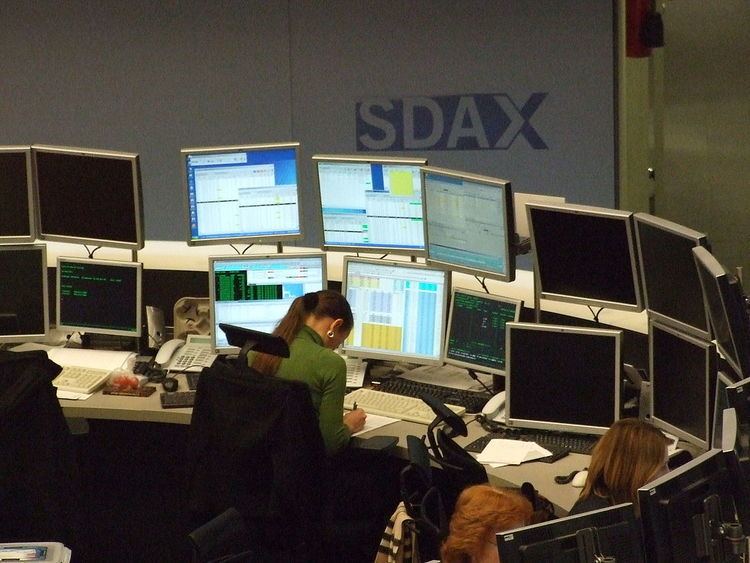Design firm Advanced Micro Devices | Introduced September 2009 | |
 | ||
Ports | ||
AMD Eyefinity is the brand name for AMD products which support multi-monitor setups by integrating multiple (up to six) display controllers on one GPU. AMD Eyefinity was introduced with the Radeon HD 5000 Series "Evergreen" in September 2009 and has been available on APUs and professional-grade graphics cards branded AMD FirePro as well.
Contents
- Overview
- Feature overview for AMD graphics cards
- Feature overview for AMD APUs
- Software support
- References
AMD Eyefinity supports a maximum of 2 non-DisplayPort displays (e.g. HDMI, DVI, VGA, DMS-59, VHDCI) (which AMD calls "legacy output") and up to 6 DisplayPort displays simultaneously using a single graphics card or APU. To feed more than two displays, the additional panels must have native DisplayPort support. Alternatively active DisplayPort-to-DVI/HDMI/VGA adapters can be employed.
The setup of large video walls by connecting multiple computers over Gigabit Ethernet or Ethernet is also supported.
The version of AMD Eyefinity (aka DCE, display controller engine) introduced with Excavator-based Carrizo APUs features a Video underlay pipe.
Overview
AMD Eyefinity is implemented by multiple on-die display controllers. The 5000-series designs host two internal clocks and one external clock. Displays connected over VGA, DVI, or HDMI each require their own internal clock. But all displays connected over DisplayPort can be driven from only one external clock. This external clock is what allows Eyefinity to fuel up to six monitors from a single card.
The entire HD 5000 series products have Eyefinity capabilities supporting three outputs. The Radeon HD 5870 Eyefinity Edition, however, supports six mini DisplayPort outputs, all of which can be simultaneously active.
The display controller has two RAMDACs which are used to drive the VGA or the DVI ports in analog mode (for example, when a DVI-to-VGA converter is attached to a DVI port), a maximum of six digital transmitters that can output either a DisplayPort signal or a TMDS signal which is used for either DVI or HDMI, and two clock signal generators needed to drive the digital outputs in TMDS mode. Dual-link DVI displays use two of the TMDS/DisplayPort transmitters and one clock signal each. Single-link DVI displays and HDMI displays use one TMDS/DisplayPort transmitter and one clock signal each. DisplayPort displays use one TMDS/DisplayPort transmitter and no clock signal.
An active DisplayPort adapter can be used to convert a DisplayPort signal to another type of signal like VGA, single-link DVI or dual-link DVI, or HDMI if more than two non-DisplayPort displays need to be connected to a Radeon HD 5000 series graphics card.
DisplayPort 1.2 added the possibility to drive multiple displays on single DisplayPort connector, called Multi-Stream Transport (MST). AMD graphics solutions equipped with DisplayPort 1.2 outputs can run multiple monitors from a single port.
At High-Performance Graphics 2010 Mark Fowler presented the Evergreen and stated that e.g. 5870 (Cypress), 5770 (Juniper) and 5670 (Redwood) support max resolution of the 6 times 2560×1600 pixels, while the 5470 (Cedar) supports 4 times 2560×1600 pixels.
Feature overview for AMD graphics cards
All AMD GPUs starting with the Evergreen series support a maximum of 2 non-DisplayPort displays and a maximum of 6 DisplayPort displays per graphics card.
The entire Radeon HD 5000 Series and Radeon HD 6000 Series. The exact technical specifications of the Radeon HD 5870 look as follows:
The entire Radeon HD 7000 Series:
The AMD Radeon Rx 200 Series all have support for (4K@60 Hz SST or MST)
Feature overview for AMD APUs
AMD Eyefinity is also available in AMD's APU branded product line, as this Civilization V running in 3x1 portrait mode multi-monitor on an Eyefinity-enabled AMD A10-7850K "Kaveri" proves. The A10-7850K is said up to four displays.
Software support
AMD Catalyst supports Eyefinity and enables the user to independently configure and run each attached displays. It facilitates the configuration of "cloned mode", i.e. to copy one desktop onto multiple screens or "extended mode", i.e. to span the workspace across multiple screens and combine the resolutions of all of those displays into one big resolution. AMD calls the extended modes Single Large Surface (SLS) and Catalyst support of certain range of display group configurations. For example, 5x1 landscape and 5x1 portrait are supported since AMD Catalyst version 11.10 from October 2011.
Starting in Catalyst 14.6 AMD has enabled mixed resolution support, allowing for a single Eyefinity display group to be created while each monitor runs at a different resolution. This feature is made possible through the addition of two new Eyefinity display modes, Fit and Expand, which join the traditional Fill mode. In both Fit an Expand mode AMD is compensating for the mismatched resolutions by creating a virtual desktop that is of a different resolution than the monitors, and then either padding it out or cropping it as is necessary.
AMD Eyefinity works with games that support non-standard aspect ratios, which is required for panning across multiple displays. SLS ("Single Large Surface") mode requires an identical display resolution on all configured displays. AMD validated some video games to support Eyefinity. The short list includes titles such as Age of Conan, ARMA 2: Operation Arrowhead, S.T.A.L.K.E.R.: Call of Pripyat, Serious Sam 3: BFE, Singularity (video game), Sleeping Dogs, Assassin's Creed II, Sniper Elite V2, Soldier of Fortune Online, Tom Clancy's Splinter Cell: Conviction, Star Wars: The Force Unleashed 2, Marvel Super Hero Squad Online, R.U.S.E., Supreme Commander 2 among others. However, some games not on this short list seem to work as well, e.g. Dirt 3 and The Elder Scrolls V: Skyrim.
KMS driver supports AMD Eyefinity.
